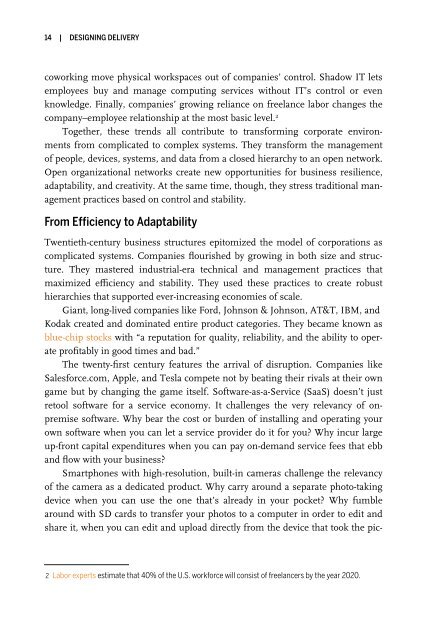Designing Delivery
1Tox6aC
1Tox6aC
Create successful ePaper yourself
Turn your PDF publications into a flip-book with our unique Google optimized e-Paper software.
14 | DESIGNING DELIVERY<br />
coworking move physical workspaces out of companies’ control. Shadow IT lets<br />
employees buy and manage computing services without IT’s control or even<br />
knowledge. Finally, companies’ growing reliance on freelance labor changes the<br />
company–employee relationship at the most basic level. 2<br />
Together, these trends all contribute to transforming corporate environments<br />
from complicated to complex systems. They transform the management<br />
of people, devices, systems, and data from a closed hierarchy to an open network.<br />
Open organizational networks create new opportunities for business resilience,<br />
adaptability, and creativity. At the same time, though, they stress traditional management<br />
practices based on control and stability.<br />
From Efficiency to Adaptability<br />
Twentieth-century business structures epitomized the model of corporations as<br />
complicated systems. Companies flourished by growing in both size and structure.<br />
They mastered industrial-era technical and management practices that<br />
maximized efficiency and stability. They used these practices to create robust<br />
hierarchies that supported ever-increasing economies of scale.<br />
Giant, long-lived companies like Ford, Johnson & Johnson, AT&T, IBM, and<br />
Kodak created and dominated entire product categories. They became known as<br />
blue-chip stocks with “a reputation for quality, reliability, and the ability to operate<br />
profitably in good times and bad.”<br />
The twenty-first century features the arrival of disruption. Companies like<br />
Salesforce.com, Apple, and Tesla compete not by beating their rivals at their own<br />
game but by changing the game itself. Software-as-a-Service (SaaS) doesn’t just<br />
retool software for a service economy. It challenges the very relevancy of onpremise<br />
software. Why bear the cost or burden of installing and operating your<br />
own software when you can let a service provider do it for you? Why incur large<br />
up-front capital expenditures when you can pay on-demand service fees that ebb<br />
and flow with your business?<br />
Smartphones with high-resolution, built-in cameras challenge the relevancy<br />
of the camera as a dedicated product. Why carry around a separate photo-taking<br />
device when you can use the one that’s already in your pocket? Why fumble<br />
around with SD cards to transfer your photos to a computer in order to edit and<br />
share it, when you can edit and upload directly from the device that took the pic-<br />
2 Labor experts estimate that 40% of the U.S. workforce will consist of freelancers by the year 2020.


